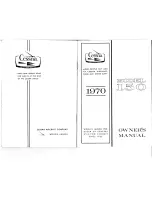
Propeller Owner's Manual
140
TESTING AND TROUBLESHOOTING
61-00-40
Page 4-4
Rev. 2 Jun/12
CAUTION:
A CALIBRATED TACHOMETER MUST
BE USED TO MAKE SURE OF THE
ACCURACY OF THE RPM CHECK.
(a) Set the brakes and chock the aircraft or tie the
aircraft down.
(b) Back the governor Maximum RPM Stop out one turn.
(c) Start the engine.
(d) Advance the propeller control lever to MAX (max
RPM), then retard the control lever one inch
(25.4 mm).
(e) SLOWLY advance the throttle to maximum manifold
pressure.
(f) Slowly advance the propeller control lever until the
engine speed stabilizes.
1 If the engine speed stabilizes at the maximum
power static RPM specified by the TC or STC
holder, then the low pitch stop is set correctly.
2 If the engine speed stabilizes above or below
the rated RPM, the low pitch stop may require
adjustment. Refer to the Troubleshooting section
of this chapter.
(g) Stop the engine.
(h) Return the governor Maximum RPM Stop to the
original position, or adjust the governor to the rated
RPM with the Maximum RPM Stop screw.
C. Static RPM Check (Non-governing Propeller)
(1) Start the engine and allow it to warm up.
(2) Check the propeller action with the propeller pitch control
(RPM control).
(3) Determine the full throttle maximum static RPM obtained
with the cockpit propeller control full forward for lowest
pitch. Refer to the airframe manufacturer's manual or the
STC paperwork for the applicable static RPM.
D. Post-Run Check
After engine shutdown, check the propeller for signs of
engine oil leakage.
Summary of Contents for HC-D2MV20-3 Series
Page 6: ...Propeller Owner s Manual 140 Page 4 Nov 02 61 00 40 MESSAGE This page is intentionally blank...
Page 202: ...Page 8 2 Nov 02 RECORDS61 00 40 Propeller Owner s Manual 140 This page is intentionally blank...
Page 204: ...Page 8 4 Nov 02 RECORDS61 00 40 Propeller Owner s Manual 140 This page is intentionally blank...













































